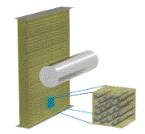Mechanical and Materials Engineering, Department of

Department of Engineering Mechanics: Dissertations, Theses, and Student Research
Date of this Version
3-2011
Document Type
Dissertation
Abstract
Modeling heat flow in bodies with discontinuities, such as cracks, or with inclusions that have different thermal properties has been a very challenging problem. Classical models lead to infinite heat fluxes at the tip of a crack and convergence of numerical methods that approximate solutions to such models have convergence and mesh dependency issues. To remove the difficulties faced by the classical models a novel nonlocal theory is formulated.
The new theory starts from the conservation of energy principle and uses the idea of nonlocal heat-transfer between material points. This idea leads to a transient heat transfer model that does not contain spatial derivative and therefore is suitable to easily treat problems with discontinuities in the temperature field, such as the case of insulating cracks. Compared with the peridynamic mechanical model, the thermal peridynamic model is obtained constructively, not postulated. The model can be applied to 1D, 2D, and 3D problems. In the new model, a peridynamic heat flux is defined and it is shown that in the limit of the nonlocal interaction zone going to zero this flux converges to the classical heat flux. A simple method compute the micro-scale parameters in the peridynamic model based on macroscopically measured material parameters is given. A mesh-free discretization method similar to a finite-volume method is used and the details of implementing the nonlocal boundary conditions (both Dirichlet and Neumann) are shown.
Convergence studies in the limit of the discrete grid spacing going to zero for a fixed horizon indicate an interesting property of the peridynamic solutions relative to those given by the classical model of transient heat conduction. Numerical experiments allow us to formulate a conjecture in this respect. Convergence studies in terms of the nonlocal region going to zero show that the peridynamic solutions converge, for well-behaved problems, to solutions of the classical, local model. In contrast with the classical model, the new peridynamic model for heat transfer can solve problems with emerging, growing, and merging discontinuities, thus it provides the first such model able to simulate heat transfer in a fracturing body. Examples of thermal heterogeneous inclusions are also shown. The advantages, in this case, compared with a Finite Element Method, for example, rest in the simplicity of discretization. In peridynamics, complex geometry is treated in the same way simple geometries are.
The new formulation can also be used to model heat/mass flow problems in biological systems with complex microstructure, in materials that undergo damage and fragmentation (thermo-mechanical fracture), or in granular systems in motion.


Comments
A dissertation Presented to the Faculty of The Graduate College at the University of Nebraska In Partial Fullfillment of Requirements For the Degree of Doctor of Philosophy, Major: Engineering (Engineering Mechanics), Under the Supervision of Professor Florin Bobaru.
Lincoln, Nebraska: March, 2011
Copyright 2011 Monchai Duangpanya